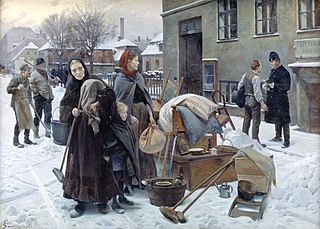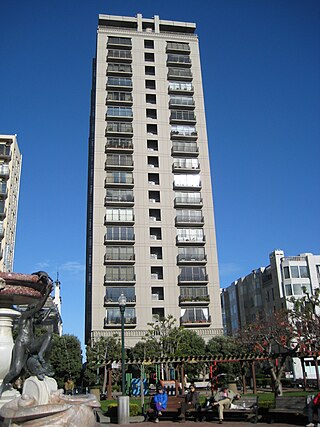Related Research Articles

Eviction is the removal of a tenant from rental property by the landlord. In some jurisdictions it may also involve the removal of persons from premises that were foreclosed by a mortgagee.

The Civil Rights Act of 1968 is a landmark law in the United States signed into law by United States President Lyndon B. Johnson during the King assassination riots.
One strike, you're out, is a colloquial term for a policy which allows tenants living in housing projects or otherwise receiving housing assistance from the federal government to be evicted if they, or any guest or visitor under their more-or-less direct control, engage in certain types of criminal activity on or, in some cases, even off the premises of said housing. This term is used because housing authorities do not have to offer a second chance. The term is apparently a back-formation of the "three strikes, you're out" concept embodied in the mandatory sentencing laws for repeat criminal offenders that began to be enacted in various American states in the 1990s.

The Anti-Social Behaviour Act 2003 (c.38) is an Act of the Parliament of the United Kingdom which almost entirely applies only to England and Wales. The Act, championed by then Home Secretary, David Blunkett, was passed in 2003. As well as strengthening the anti-social behaviour order and Fixed Penalty Notice provisions, and banning spray paint sales to people under the age of 16, it gives local councils the power to order the removal of graffiti from private property.
A civil gang injunction or CGI is a type of restraining order issued by courts in the United States prohibiting gang members in particular cities from participating in certain specified activities. It is based on the legal theory that gang activity constitutes a public nuisance that can prevent non–gang members of the community from enjoying peace and public order. An injunction is obtained against the gang itself, after which the police and district attorney may decide against whom they will enforce it. Law enforcement use gang injunctions as a tool to label people as gang members and restrict their activities in a defined area (ACLU).

In criminology, public-order crime is defined by Siegel (2004) as "crime which involves acts that interfere with the operations of society and the ability of people to function efficiently", i.e., it is behaviour that has been labelled criminal because it is contrary to shared norms, social values, and customs. Robertson (1989:123) maintains a crime is nothing more than "an act that contravenes a law". Generally speaking, deviancy is criminalized when it is too disruptive and has proved uncontrollable through informal sanctions.
Habitability is the adequacy of an environment for human living. Where housing is concerned, there are generally local ordinances which define habitability. If a residence complies with those laws, it is said to be habitable. In extreme environments, such as space exploration, habitability must take into account psychological and social stressors, due to the harsh nature of the environment.
Self-help, in the context of a legal doctrine, refers to individuals exercising their rights without resorting to legal writs or consulting higher authorities. This occurs, for example, when a financial institution repossesses a car on which it holds both the title and a defaulted note. Individuals may resort to self-help when they retrieve property under the unauthorized control of another person or abate nuisances, such as using sandbags and ditches to protect land from flooding.
Landlord harassment is the willing creation, by a landlord or their agents, of conditions that are uncomfortable for one or more tenants in order to induce willing abandonment of a rental contract. This is illegal in many jurisdictions, either under general harassment laws or specific protections, as well as under the terms of rental contracts or tenancy agreements.
The Arkansas Legal Services Partnership was a consortium of two nonprofit legal services programs, the Center for Arkansas Legal Services and Legal Aid of Arkansas, that worked together to provide free civil legal assistance to low-income residents throughout Arkansas. While the two nonprofits still collaborate, the Arkansas Legal Services Partnership no longer exists.
An emotional support animal (ESA) is an animal that provides support to individuals with a mental health or psychiatric disability. Emotional support animals are not required to be trained. Any animal that provides support, comfort, or aid, to an individual through companionship, unconditional positive regard, and affection may be regarded as an emotional support animal.
Nuisance abatement is a growing area within policing and code enforcement. The term refers to using building codes, fire codes, zoning, etc. in order to improve the quality of life and resolve life safety issues within neighborhoods. Nuisance abatement programs are most often a component of problem oriented or community policing programs. In most Canadian jurisdictions, bylaw enforcement officers handle nuisance abatement.

Discrimination against homeless people is categorized as the act of treating people who lack housing in a prejudiced or negative manner because they are homeless. Other factors can compound discrimination against homeless people including discrimination on the basis of race, gender, sexuality, age, mental illness, and other considerations.
Fergus and Judith Wilson are a British married couple who were among the UK's largest buy-to-let investors. At peak, they owned approximately 1,000 two- and three-bedroom properties around Ashford and Maidstone in Kent. In 2008 they were listed at #453 on The Sunday Times "rich list", with a fortune of £180 million. By 2019 it was incorrectly reported that they had sold all their properties, however in 2022 in the High Court, Ashford Borough Council secured a permanent Freezing Injunction against Mr Fergus Wilson, the effect of which prevents him from disposing of assets, including in the form of five named properties, the Council took the action because Mr Wilson defaulted on three Court judgments relating to the payment of legal costs. Mr Wilson and his wife were rapidly disposing of their assets and the Council believed there is a real risk that the costs orders of the court will go unsatisfied.

Landlord–tenant law is the field of law that deals with the rights and duties of landlords and tenants.

Domestic violence is a form of violence that occurs within a domestic relationship. Although domestic violence often occurs between partners in the context of an intimate relationship, it may also describe other household violence, such as violence against a child, by a child against a parent or violence between siblings in the same household. In the United States, it is recognized as an important social problem by governmental and non-governmental agencies, and various Violence Against Women Acts have been passed by the US Congress in an attempt to stem this tide.
The Costa–Hawkins Rental Housing Act ("Costa–Hawkins") is a California state law enacted in 1995, placing limits on municipal rent control ordinances. Costa–Hawkins preempts the field in two major ways. First, it prohibits cities from establishing rent control over certain kinds of residential units, such as single-family dwellings, condominiums, and newly constructed apartment units. Second, it prohibits "vacancy control", also called "strict" rent control. The legislation was sponsored by Democratic Senator Jim Costa and Republican assembly member Phil Hawkins.
Domestic violence and abuse in the United Kingdom are a range of abusive behaviours that occur within relationships. Domestic violence or abuse can be physical, psychological, sexual, financial or emotional. In UK laws and legislation, the term "domestic abuse" is commonly used to encompass various forms of domestic violence. Some specific forms of domestic violence and abuse are criminal offences. Victims or those at risk of domestic abuse can also be provided with remedies and protection via civil law.

Eviction in the United States refers to the pattern of tenant removal by landlords in the United States. In an eviction process, landlords forcibly remove tenants from their place of residence and reclaim the property. Landlords may decide to evict tenants who have failed to pay rent, violated lease terms, or possess an expired lease. Landlords may also choose not to renew a tenant's lease, however, this does not constitute an eviction. In the United States, eviction procedures, landlord rights, and tenant protections vary by state and locality. Historically, the United States has seen changes in domestic eviction rates during periods of major socio-political and economic turmoil—including the Great Depression, the 2008 Recession, and the COVID-19 pandemic. High eviction rates are driven by affordable housing shortages and rising housing costs. Across the United States, low-income and disadvantaged neighborhoods have disproportionately higher eviction rates. Certain demographics—including low income renters, Black and Hispanic renters, women, and people with children—are also at a greater risk of eviction. Additionally, eviction filings remain on renters' public records. This can make it more difficult for renters to access future housing, since most landlords will not rent to a tenant with a history of eviction. Eviction and housing instability are also linked to many negative health and life outcomes, including homelessness, poverty, and poor mental and physical health.
The Crime-Free Multi-Housing (CFMH) program is a crime-free ordinance program, which partners property owners, residents, and law-enforcement personnel in an effort to eliminate crime, drugs, and gang activity from rental properties.
References
- ↑ "I Am Not A Nuisance: Local Ordinances Punish Victims Of Crime". aclu.org. American Civil Liberties Union. 2021. Retrieved December 17, 2021.
- 1 2 3 Katach, Salim (Spring 2015). "A Tenant's Procedural Due Process Right in Chronic Nuisance Ordiance Jurisdictions". Hofstra Law Review . 43 (3): 875–908. Retrieved December 20, 2021.
- ↑ Gavin, Amanda K. (2014). "Chronic Nuisance Ordinances: Turning Victims of Domestic Violence into "Nuisances" in the Eyes of Municipalities" (PDF). Penn State Law Review . 119 (1): 257–278. Retrieved January 4, 2022.
- ↑ Kastner, Anna (August 2015). "The Other War at Home: Chronic Nuisance Laws and the Revictimization of Survivors of Domestic Violence". California Law Review . 103 (4): 1047–1079. Retrieved January 4, 2022.
- ↑ Haderlie, Elizabeth; Shaaban, Layla (April 2021). "Domestic Violence Victims, A Nuisance to Society?: Moving Toward A More Equitable System in Protecting Vulnerable Women". Brigham Young University Prelaw Review . 35 (12): 139–154. Retrieved January 4, 2022.
- ↑ Holtzman, Emily (2020). "Protecting Victims of Domestic Violence from Chronic Nuisance Ordinances". Tennessee Journal of Race, Gender, & Social Justice . 9 (1): 44–65. doi:10.70658/2693-3225.1166 . Retrieved January 4, 2022.
- ↑ "Office of General Counsel Guidance on Application of Fair Housing Act Standards to the Enforcement of Local Nuisance and Crime-Free Housing Ordinances Against Victims of Domestic Violence, Other Crime Victims, and Others Who Require Police or Emergency Services" (PDF). hud.gov. United States Department of Housing and Urban Development. September 13, 2016. Retrieved January 4, 2022.
- ↑ Mead, Joseph; Hatch, Megan E.; Tighe, J. Rosie; Pappas, Marissa; Andrasik, Kristi; Bonham, Elizabeth (March 24, 2018). "Treating Neighbors as Nuisances: Troubling Applications of Criminal Activity Nuisance Ordinances" (PDF). Cleveland State Law Review . 66 (3): 1–15. Retrieved January 4, 2022.
- ↑ Jarwala, Alisha; Singh, Sejal (July 2019). "When Disability Is a 'Nuisance': How Chronic Nuisance Ordinances Push Residents with Disabilities Out of Their Homes" (PDF). Harvard Civil Rights–Civil Liberties Law Review . 54: 875–915. Retrieved January 4, 2022.
- ↑ Arnold, Gretchen W. (May 2016). "From Victim to Offender: How Nuisance Property Laws Affect Battered Women". Journal of Interpersonal Violence . 34 (6): 1103–1126. doi:10.1177/0886260516647512. PMID 27150284. S2CID 41566514 . Retrieved January 4, 2022.